Unashamed Authenticity: UVU Humanities Symposium Presentation
Update: The video of this presentation is now available in Spanish and Portuguese.
On Thursday, February 17, 2022, I had the opportunity to present at a symposium hosted by the Humanities Department at Utah Valley University. The title of my presentation was “Unashamed Authenticity: Unapologetically Navigating the Queer/Latter-day Saint Intersection during an Ongoing Restoration.”
The Symposium is an annual event where the Humanities Program engages the campus community and the general public in interdisciplinary and up-to-the-moment discussions on art, culture, and theory, demonstrating that the Humanities are an important lens through which we interpret our lives and the events that are happening in the world right now.
I invite you to watch my presentation above. You can also read my presentation along with my slides below. You can also download a copy of my presentation.

Good morning! I bring you greetings from the margins and am excited to discuss what is currently happening in the Queer/Latter-day Saint intersection.

Affirmation was founded in 1977 and is now 45 years old. We have grown up side by side the LGBTQ civil rights movement.
Before 1977, many groups of gay Mormons informally met together in secret because it was dangerous to do so otherwise. One of these informal groups was BYU students. Between 1976 and 1977 two of these students submitted to electroshock therapy in an attempt to cure their orientation. When the therapy failed, they became overwhelmed by feelings of massive unworthiness, which they felt they could only resolve by taking their own lives. Both had been counseled by ecclesiastical leaders to cut off contact with all gay friends as part of their “recovery” process—thus cutting themselves off from a network which might have been able to provide the support necessary to prevent their deaths. In that moment, this group of friends determined that a formal support network was essential and lifesaving for gay and lesbian Mormons—and Affirmation was officially born.

In the ensuing 45 years, Affirmation has grown in size and scope around the world, because where ever the Church is, Queer people are also. Today, encompassing sexual orientation, gender identity, and gender expression, we build communities of safety, love, and hope around the world for LGBTQ people who occupy the same kinds of intersections our siblings did in 1977—and true to our founding roots, we still to this day look out and care for our friends.
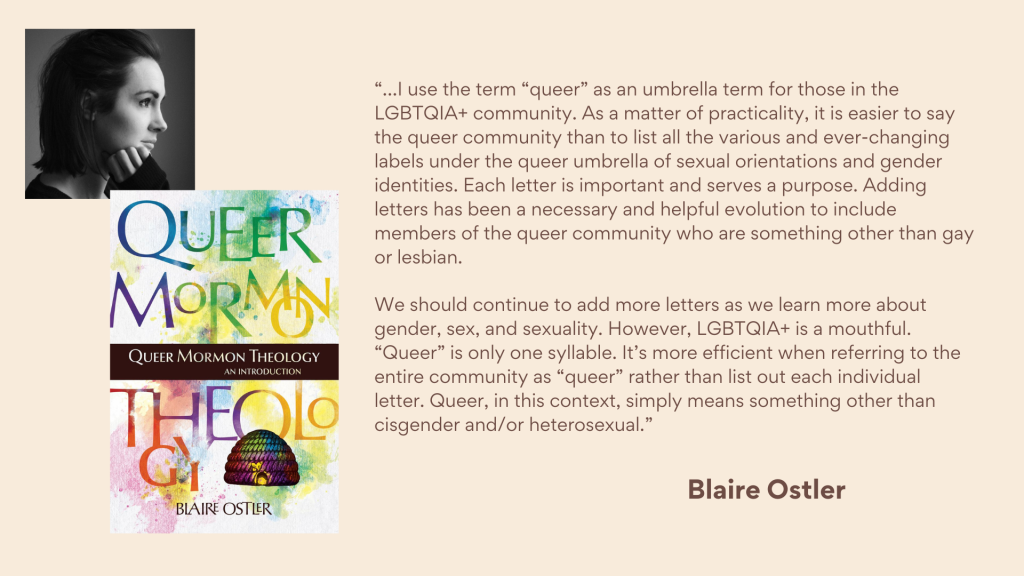
Before I begin, why the word Queer? Blaire Ostler writes in her book “Queer Mormon Theology”:
“…I use the term “queer” as an umbrella term for those in the LGBTQIA+ community… It’s more efficient when referring to the entire community as “queer” rather than list out each individual letter. Queer, in this context, simply means something other than cisgender and/or heterosexual.”
Following Blaire’s lead, I will use “Queer” in today’s presentation as an interchangeable umbrella identifier with an occasional use of LGBTQ or LGBTQIA+ because that is currently how you will hear the conversation within our community.
I highly recommend Blaire’s book. It is a thoughtful work in our own Latter-day Saint theology where Jesus is not wiping away our queerness, but is instead the Christ who experiences queerness with us.
The take home point is that the word “Queer” originated as a denigrating and violent slur that the younger LGBTQ generations have now reclaimed and empowered. More and more it is being used in the academic community as well. However, it is not a universal personal identity, and it is standard that you ask a person how they want to be identified and then honor that.
Also, when we look at what the LGBTQIA+ letters mean, it describes both sexual orientation and gender identity. Those two things are not the same and it is important to realize that even though we as a community show up together and show up for each other, experiences surrounding gender identity are completely different from those revolving around sexual orientation. I will be clear today when I am speaking about sexual minority experiences, gender identity experiences, or situations and experiences that affect our collective Queer community.

Today I am speaking from a Queer-centric position, unashamedly and authentically telling of the conditions and experiences in this intersection.
In the past when a Queer person intersected with the Church, this intersection was defined by the Church where the Church assigned meaning to your experience and identity. They ran the show. A Queer person’s worth and value was measured by the yardstick of “What does the Church think about Queer people?”

The problem of this perspective is: what the Church authoritatively thinks about Queer people has drastically changed over the years. The constant parade of Church books, talks, websites and policies about Queer people over the past seventy plus years illustrates this change. Kyle Ashworth of Latter-Gay Stories has done a phenomenal job documenting this change.
This continual changing perspective of “What the Church thinks” has become a moving target and tiresome to chase. To tie your self-worth and commit your life’s future to changing opinions and shifting sentiments, no matter how authoritative they may be, is building your life and self on a foundation of sand. It is dangerous to your mental, emotional, physical, and spiritual health.
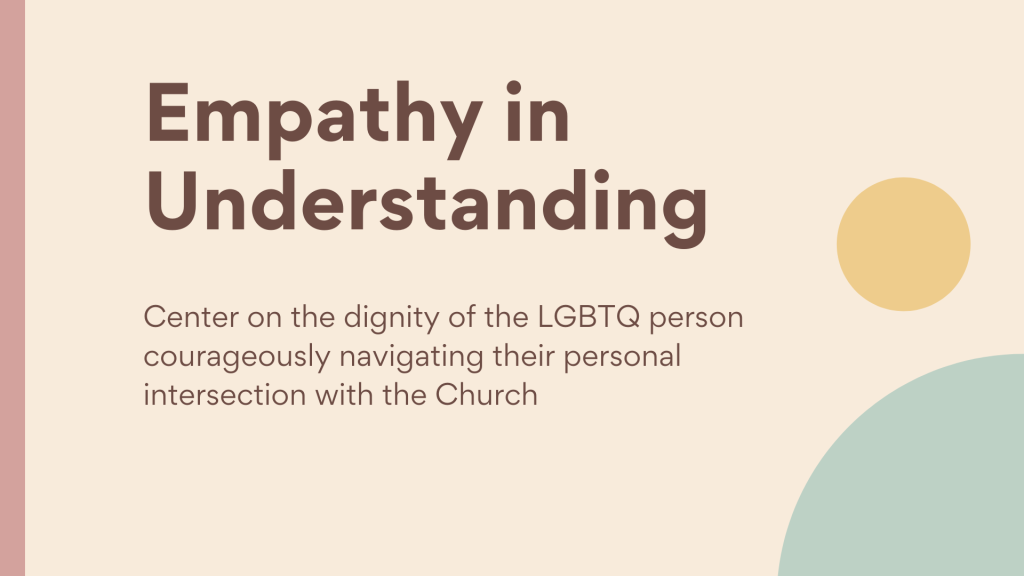
Being Queer centric means that instead of being tossed to and fro by the changing and shifting sentiments currently defining Queer folk, you instead center on the dignity of the Queer person courageously navigating their personal intersection with the Church. People over ideas is always good policy. This is the healthiest of all premises for Queer individuals and their families.
Each queer person owns their own intersection with the Church. They are the ones who are navigating it. They get to define it and they get to assign meaning to their experiences there.
In this intersection, we understand ourselves, even when authorities tell us that we really don’t. In this intersection it’s OK to speak up and change the narrative. It’s even OK to walk away when confronted with prejudice, harassment, and discrimination.
Today we celebrate the Queer navigator not at the expense of the truth or belief in the Church, but in celebration and affirmation of the Queer soul. Today is not an us vs. them moment.
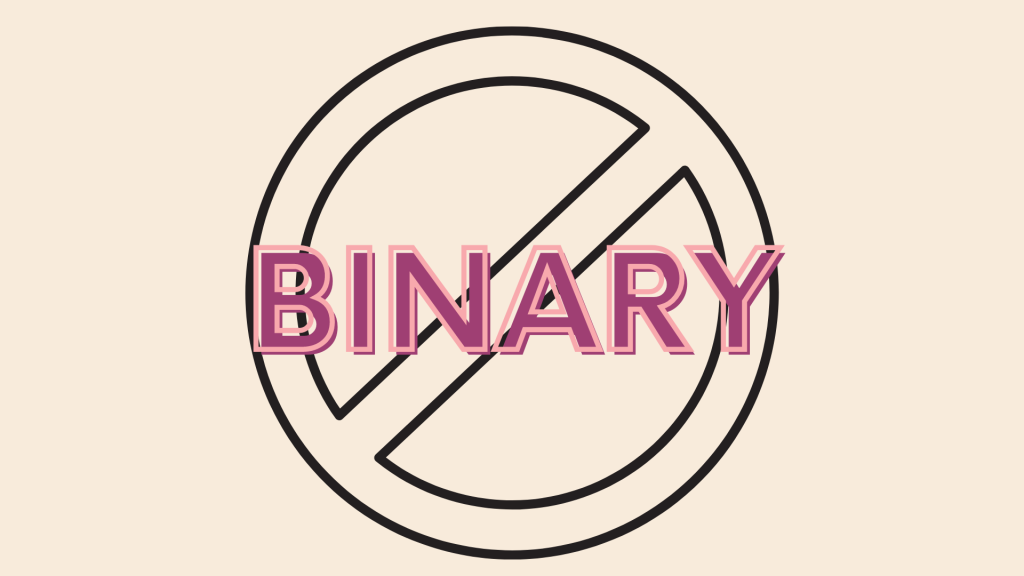
If you start to hear this presentation today in binary, either pro-Church/anti-Church, Mormon/Ex-Mormon, belief vs. unbelief, or us vs. them, that means you have slipped off the center road and have run yourself into the binary rut of ideologies on either side of this discussion. Today I need you out of the rut, because when we focus on the human, the person, the navigator, we are in the place where the most productive and helpful discussions are happening. This is the space where change happens, not in the rut of binary thinking.

I want to be perfectly clear. I am not telling people to stay in the Church or leave the Church. Everyone navigating their intersection with the Church must figure out what they want to do and where to be that feels safe and healthy for them.
The Queer Latter-day Saint community is not a monolith. Understanding this on a deep level, at all times I will be respectful of the experience of every queer person navigating their personal faith intersection as they claim their right to stand in places that feel safe and healthy for them including how they choose to interact with the Church of Jesus Christ of Latter-day Saints. I will not be so generous to power centers that litter this intersection with prejudice, harassment, and discrimination towards Queer people and their families.

Today is about Queer empowerment and equality, and the oft overlooked aspect of the Queer human experience: The right to choose to worship how, where, and what we may in the equality of our straight, cisgender peers.
Today we will confront the Queer/Latter-day Saint intersection.
Just know that talking about the intersection is not for the faint of heart and it may feel a little uncomfortable at times, because it is easy as a Church or as a non-queer person to become defensive and dismissive when you hear about Queer people having a rough time navigating a heterosexual cisgender system when you don’t see or feel a problem.
But stick with me, it is worth the effort.
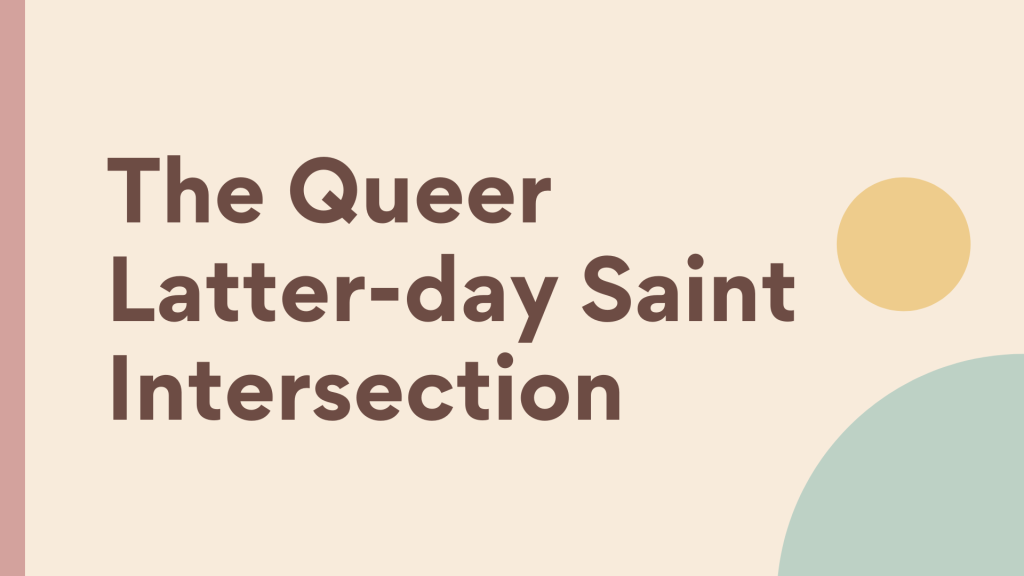
Let me introduce the intersection as it stands today:

A few years ago, my family met up with my sister’s family who live in Seattle. We rented a boat and navigated around the San Juans for a week. It is an amazing part of the country. To do this safely you need to know both where you are at in open water and you need to know the underwater hazards you cannot see. Relying on the GPS/Sonar system allowed us to safely enjoy our time in the San Juans and not end up out in the open ocean or sink the boat to the bottom of a channel.

Latter-day Saints have a navigation system that allows us to see the big picture as we chart our course here in mortality. It is called the Plan of Salvation or Plan of Happiness.
If you are a straight/cisgender person, your belief and faith will navigate you successfully all the way to the top to live with God again because two particular actions to get there — presenting at the judgement bar as the gender you were assigned at birth and being married to someone (or in the case of polygamy—married to others) of the opposite sex—are decidedly heterosexual/cisgender actions.
All else being equal in our belief and faith, authentic Queerness bars us entry.
I see this as a “theology incomplete” in an ongoing restoration. Others see it as a core feature that must be defended at all cost, including human cost.
Because this is just the way it is right now, the Church doesn’t know what to do with us here in mortality. They hold us, infantilize us, and segregate us both culturally and theologically. This creates the conditions in our spiritual home that we encounter in the Queer/Latter-day Saint intersection. It would be nice if our spiritual home looked the same as our straight/cisgender peers does. But it doesn’t. It is a very different experience with different rules and different expectations.

A couple years ago I wrote an opinion piece for the Salt Lake Tribune highlighting the main feature of the Queer/Latter-day Saint intersection: The Rainbow Stained Glass Ceiling.
We are familiar with the term “Glass Ceiling” that refers to a real but invisible barrier that prevents women from rising beyond a certain level in a hierarchy. In the Church we have a rainbow stained glass ceiling for Queer Latter-day Saints. It is firmly in place to prevent Queer people from rising alongside their straight cis-gender peers in privilege and opportunity.
The rainbow stained glass ceiling is central to the Queer/Latter-day Saint intersection here in mortality. For sexual minorities it is marriage equality. For transgender Latter-day Saints it is transitioning. It is what EVERY Queer Latter-day Saint is currently aware of, fearful of, navigating under, crashing against, or navigating away from. I’ll walk you through this intersection now. It does not exist for straight/cisgender Latter-day Saints.
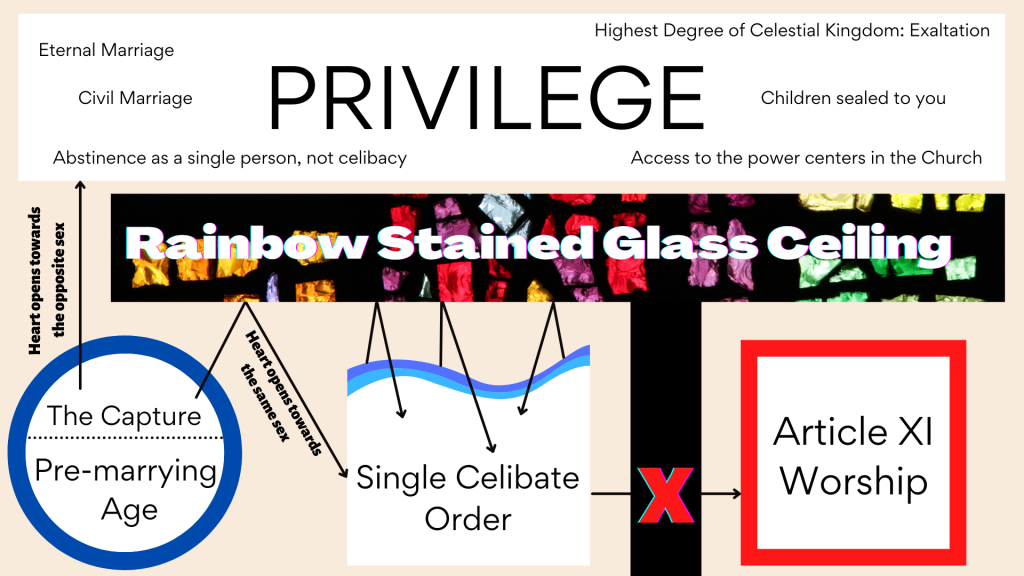
Here is the landscape of this intersection. It is a “plan of salvation” type map of what happens above and below the rainbow stained glass ceiling for both sexual minorities and transgender Latter-day Saints here in mortality.
Above the rainbow stained glass ceiling is privilege, below the ceiling are where Queer Latter-day Saints are held, and I might add we are told we are lovingly held there, by acts of prejudice, a.k.a. discrimination.
Privilege and acts of prejudice look a bit different between sexual minorities and transgender Latter-day Saints.
On this slide I’ll illustrate what it looks like for Latter-day Saint sexual minorities but as we go along, I will discuss the environment transgender Latter-day Saints encounter below and above the ceiling as well.
Let’s start at the lower left.
1. In the short run all our youth and young adults in the Church are expected to refrain from sexual relations of any kind. This is an equal ask of all sexual orientations.
2. Then one day amidst a feeling of living equally among your peers, there is the capture. For sexual minorities, marrying age typically is the moment of reckoning where you realize that all this time your straight peers have been living abstinence, while you have been living celibacy. Abstinence is waiting until marriage. Celibacy is the discipline of waiting forever because marriage is not approved for you. This is when our sexual minorities are carefully captured and funneled into the unofficial celibate order of the Church. This is not a celibate order of religious elites as in Catholicism where the celibate order runs the church. This is a second-class subgroup under the suspicious gaze and supervision of the straight majority.
Now, if someone chooses to be single, no matter their sexual orientation, I am all for that. They have self-determined that is what’s best for them. However, to force celibacy as the only option for sexual minorities if they want to remain a part of their spiritual home — to belong — is an act of prejudice. Forced celibacy under threat that you won’t belong anymore if you don’t comply is so very harmful to one’s mental, emotional, physical, and spiritual health.
It used to be that the Church counseled gay men to marry a woman as a type of conversion therapy to be able to partake of the kind of marriage that leads to exaltation. That policy turned out to be so disastrous and dangerous for everyone involved that the Church finally stopped the practice. It is no longer the policy of the Church; it is no longer an official option.
3. If you do find the love of your life and marry, you will violently crash up against the impenetrable rainbow stained glass ceiling. You will be invited to divorce or else be excommunicated. There is no polite way to say it. This is spiritual violence to tear a family apart.
You might think that excommunication after marriage means all sexual minorities avoid the Church. But it is not exactly like that. Queer people have a right to exercise their faith in spaces that feel safe and healthy for them. Some excommunicated Queer people sit in the pews alongside members of the Church to worship. Excommunicated Queer folk worship with the Saints under the Article XI worship clause.
What is Article XI worship? Its name comes from the 11th article of Faith: “We claim the privilege of worshiping Almighty God according to the dictates of our own conscience, and allow all men the same privilege, let them worship how, where, or what they may.”
As far as the Church is concerned as a Queer Excommunicant, you are sitting with the Saints, but worshiping how, where, or what you may—not the Latter-day Saint way because you claimed marriage equality. Article XI worship is a “Visitors Welcome” policy, a way to feel “belonging” without actually belonging.
The Church regularly cleans house under the rainbow stained glass ceiling to maintain these boundaries, getting rid of those who stray into equality. This is done either by using BYU standards or non-BYU standards. BYU standards prohibit our single celibate order from any chaste romantic behavior. Bishops and stake presidents outside BYU are not in agreement, often allowing the celibate order to date, hold hands, kiss, and even live together as partners as long as they can check-in with their priesthood leaders and declare that they are not doing “the deed.”
Navigating the rainbow stained glass ceiling of transition looks a bit different for transgender Latter-day Saints.
1. If you are transgender or non-binary, until you come out or chose to transition, you start your experience in the Church mingled among your cisgender peers. Probably experiencing gender dysphoria, but as long as you do not transition, you fly under the radar unnoticed.
2. For transgender Latter-day Saints, the capturing begins when you come out or transition. The Church opposes any form of transitioning and states that any form of transitioning will result in restrictions of privilege.
3. Those restrictions are very dependent on your local priesthood leader’s understanding and preference. It becomes very subjective, which is dangerous for transgender Latter-day Saints because you now must navigate a whole set of unwritten rules unique for where you live.
Privilege in the case of our transgender Latter-day Saints is to be able to live unrestricted in the same privileges their cisgender peers enjoy above the rainbow stained glass ceiling. The official stance of the Church says “Although some privileges of Church membership are restricted, other Church participation is welcomed.” But depending on where you live, you can still enjoy some access like attending Relief Society or Priesthood according to your own gender, expressing your gender authentically, or serving in a few limited callings
Again, like with sexual minorities, there is a harsh BYU standard and a hometown bishop/stake president standard of enforcement in this intersection. We see this as recently as last week when BYU dismissed three transgender clients from the on-campus BYU speech and language clinic because their speech therapy health care as transgender students — which BYU considers a form of transitioning — is a violation of Church policy and they will have none of that on campus.
However, it is very different in wards and stakes around the world. For example, we know of a trans woman who remains married to her wife of 30+ years and they have been called and sustained to serve as primary teachers together, where immediately prior to transitioning she was the 1st counselor to the bishop. But then we are aware of other wards and stakes that create a hostile environment for those who are socially transitioning, and in some cases excommunicate those who socially transition. It is truly all over the map.
The take home point when understanding the physical make-up of this intersection is that it comes from a place of prejudice. And the way that this prejudice structures the everyday life of Queer Latter-day Saints leads to harassment and discrimination in the Church.
Why is there is a Queer/Latter-day Saint intersection to begin with?
At the core of any religion is a set of sincerely held ideas and beliefs that create doctrine.
Each religious system has boundaries to maintain doctrine and does so in two basic ways.

1. It needs a way to keep unauthorized external ideas out—keep certain people out, keep certain behaviors out, keep out invaders, the government, the “world.” You accomplish this by strengthening the borders of your “religious freedoms” argument. A church has a lot of latitude to govern itself and treat its members how it wants, just as long as it stays on the right side of the law.
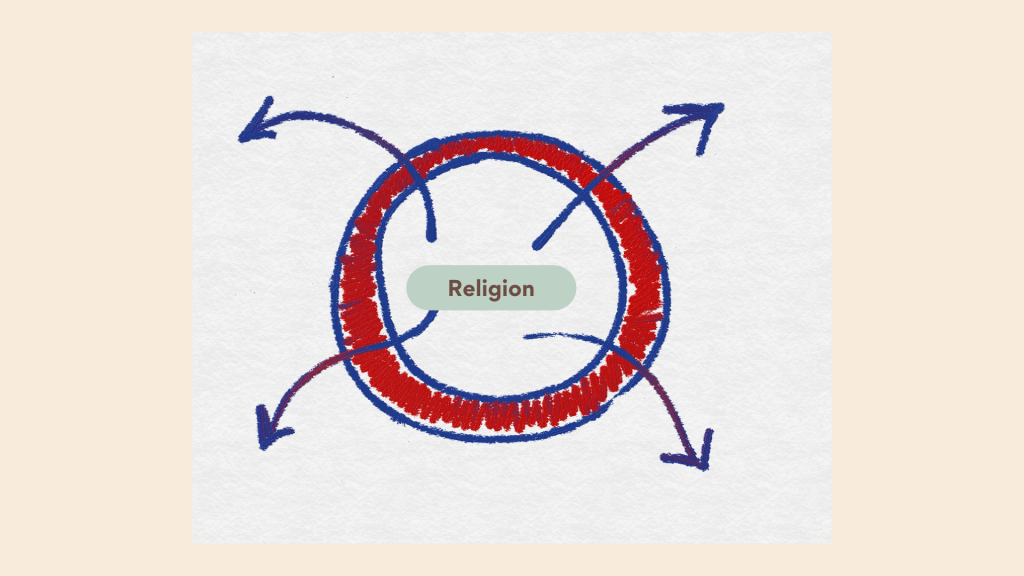
2. Churches also need a way to get unauthorized internal ideas out. For example, call to repentance, excommunication, burning at the stake, imprisonment. People hosting the wrong ideas are heretics and apostates and are removed by such a process.
Boundary protection against external threats went severely wrong with polygamy in the Church.

We live in a Church that since its inception reserves the absolute right to doctrinally define marriage. In the mid to late 1800s the Church held as a central core belief that polygamy was the highest order of marriage and only those who practiced it would go to the highest degree of the Celestial Kingdom. The United States Government felt differently about the practice and came to Utah to stomp it out.
In 1904, after years of experiencing the full force and resources of the United States government, the church had no recourse but to make its final pivot away from the practice of plural marriage. The end of polygamy signaled that the federal government had successfully regulated the behavior of the members of The Church of Jesus Christ of Latter-day Saints against their own doctrine, against their identity as a Church, and against their lived experience.
It was a humiliating experience to be violated like that. Queer people know exactly what it is like to be violated by laws and court rulings.

This historical trauma of having polygamous behavior so soundly regulated into civil oblivion created a “Never Again” hyper-vigilance — creating an intense push of vast amounts of resources into strengthening religious freedoms borders to keep the federal government, or any government for that matter, from ever walking through the Church doors again and dictating the definition of marriage within the Faith. We have an extremely politically active Church not just in the US, but the Church is extremely active in countries where Queer civil rights movements are still in their infancy, working diligently to help enact anti-queer laws, so other governments don’t breach the walls.
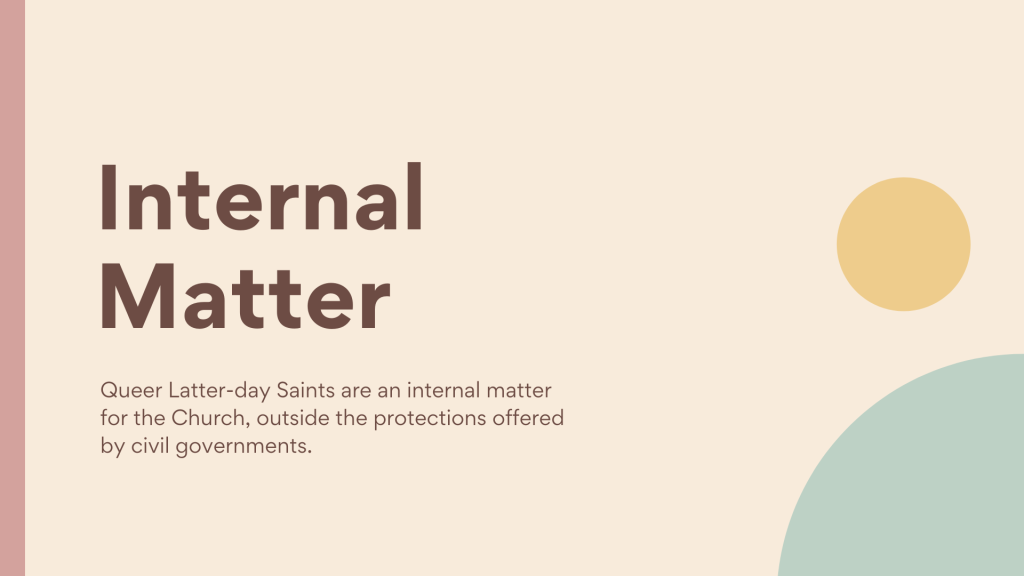
The Church is active on another front, one that they consider an internal matter. Queer equality is an unauthorized internal idea. There are elaborate management mechanisms put in place to prevent equality or get rid of people who demonstrate equality. It’s a full-time job because Queer people are continually being born into the Church. We are a perpetually renewing internal resource that never, ever will go away.

The “General Handbook: Serving in The Church of Jesus Christ of Latter-day Saints” has a new section for leaders and members entitled “Prejudice.”
“The Church calls on all people to abandon attitudes and actions of prejudice toward any group or individual… This includes prejudice based on race, ethnicity, nationality, tribe, gender, age, disability, socioeconomic status, religious belief or nonbelief, and sexual orientation.”
That is quite the list.
But this list is not what it appears to be. The words I put in bold highlight the fatal disconnect the Church has with its Queer members.
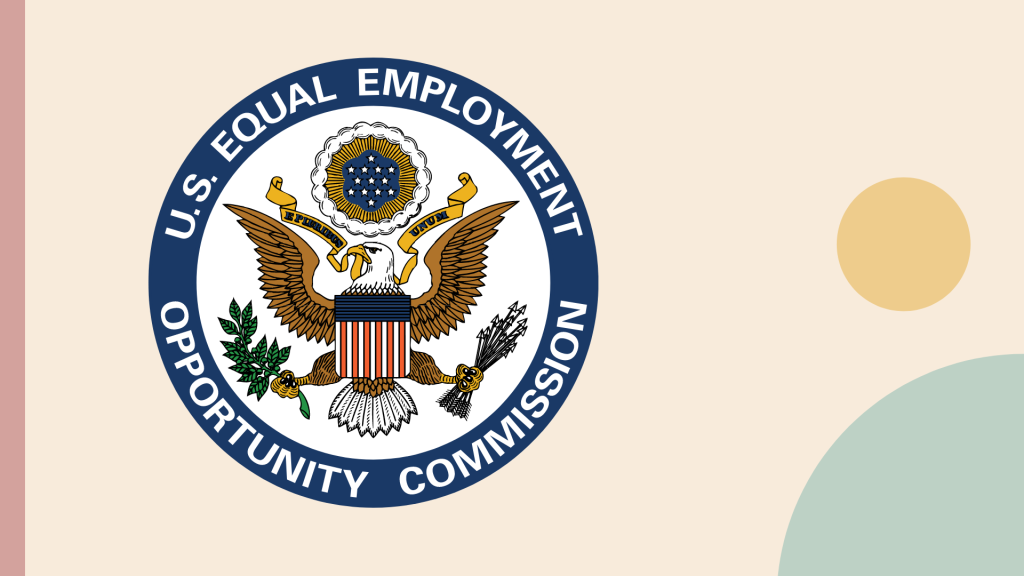
At first glance, this list elicits positive associations because it is fabricated to look like the familiar EEOC non-discrimination list we all see at work. The addition of “sexual orientation” in the list also adds to the vibe that a protective environment of equal opportunity and non-discrimination exists for Queer people in the Church.
During subsequent glances, the EEOC mimicry falls away. Especially when you try to resolve the dissonance between “actions of prejudice” with how life in the Church is currently structured for Queer Latter-day Saints.
This statement in the handbook is not a protective anti-discrimination statement for Queer members and we are all confronted with a confusing dilemma of dissecting exactly what this list is and what “prejudice” and “acts of prejudice” towards Queer members means in the Church.
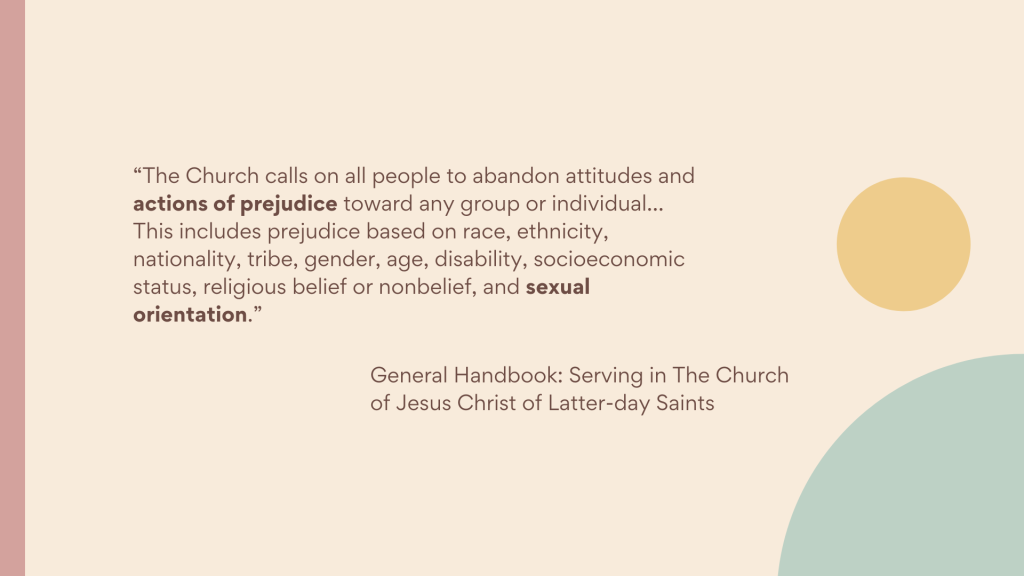
To a typical reader of the Church handbook, “prejudice” is a personal attitude not based on reason or actual experience and “actions of prejudice” is discrimination. Therefore, it would be reasonable to read this as a statement against prejudice and discrimination. However, nothing could be further from the truth.
When you define “prejudice” in a religious setting, such as in the Church and handbook, you insert God into the equation. Prejudice now becomes a preconceived opinion about Queer people that is based on the power structure’s understanding of what God thinks about Queer people. Because of this, “acts of prejudice” are morally acceptable if done in the name of God.
From this position the Church can reasonably claim to hold no prejudice towards Queer people while creating and enforcing a unique and inequitable religious standard in the name of God. The Handbook section on prejudice is ironically a statement founded in Queer prejudice.
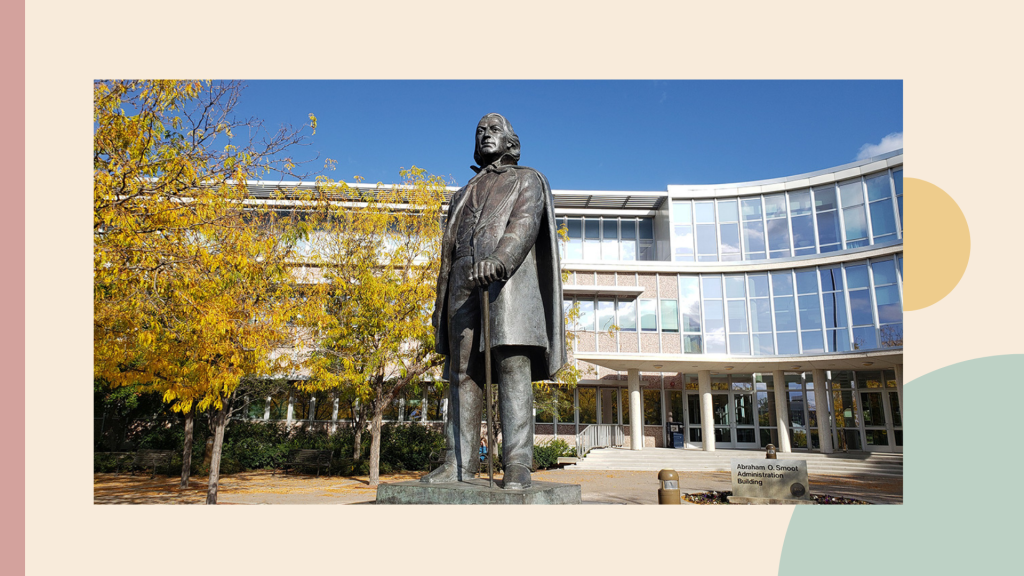
Steve Sandberg, Brigham Young University’s general counsel, summed it up best when we met together in the Fall of 2019 to discuss the discriminatory treatment of Queer BYU students on campus. After pointing out the absence of sexual orientation and gender identity in the university’s nondiscrimination statement and how that absence exposes Queer students and visiting faculty to harm, Mr. Sandberg explained that BYU, as with all religious universities in America, has the protection to create its own nondiscrimination policies that align with its doctrine, as long as they do not conflict with federal, state, and local laws. What may be seen as inequitable to others are protected religious tenets of belief.
If it is not obvious to you yet, it has been very obvious to the Church since it’s tussle with the Federal Government over polygamy. You need laws that will allow you to practice ideas that people on the outside may find objectionable. In the late 1800s, early 1900s it was polygamy. Today, Queer issues are seen as an external invader and the best way to ensure that there are laws in place to protect your religious liberties to perform acts of prejudice against other people, is to have a very heavy hand in the legislative process. This is why we have a very politically active Church.
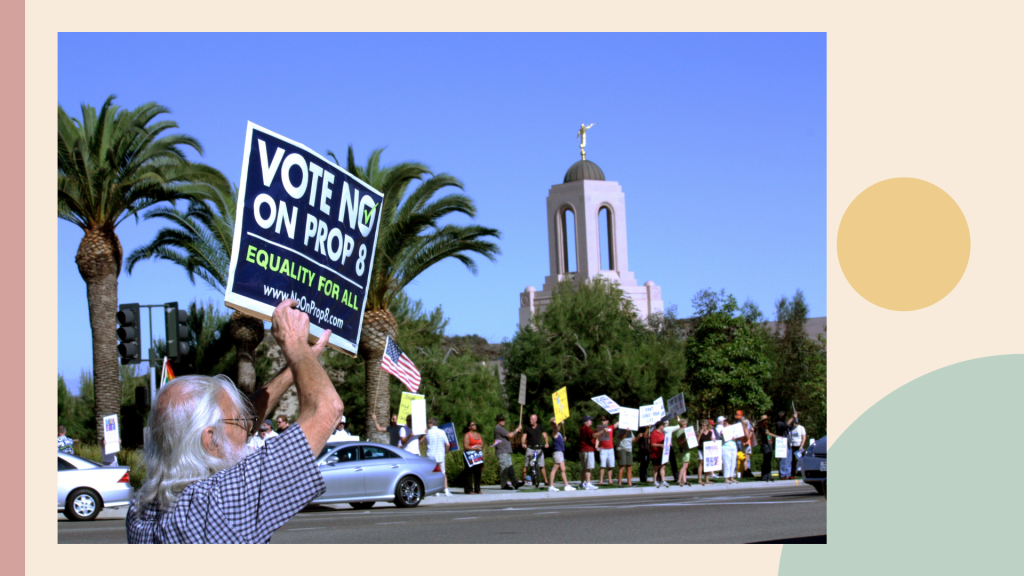
For a long time, and by long time I mean starting in the 1990s, the Church strictly maintained a highly adversarial stance with the LGBTQ community in the legislative process.
But then something happened in the timeline. The church started losing in the courts. An adversarial relationship at the legislative level was not working because the courts were ruling for equality and civil rights. In the face of these court losses, the Church saw the writing on the wall that LGBTQ civil rights were going to happen in the United States and it was time to pivot in strategy in order to protect its ability to maintain prejudice and acts of prejudice in house, protected by religious freedom. By the time marriage equality had been upheld by the Supreme Court in June of 2015 with the Obergefell ruling, the Church had quietly abandoned the adversarial approach that made it famous in the 1990s, California Prop 8 for example, for a cooperative approach, where high priority was given to building relationships with Queer community leaders.
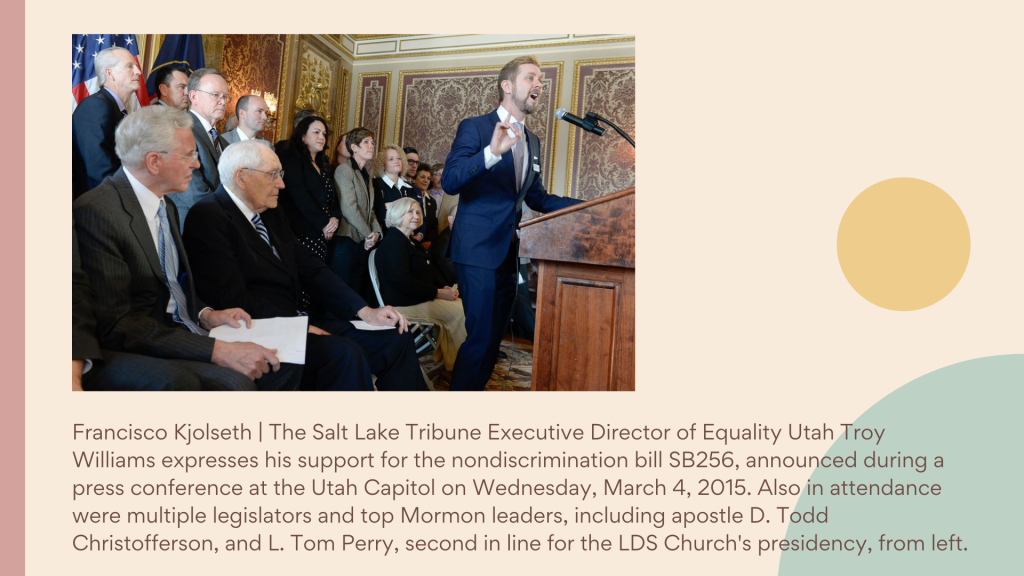
You might remember the Utah Compromise that was enacted in 2015 banning discrimination against Queer people in housing and employment, while also protecting religious institutions that object to homosexuality and self-determination of gender identity. The relationship required to make such a compromise didn’t happen overnight, and it continues mainly under the radar today.
A few months ago, President Dallin H. Oaks spoke at the University of Virginia. His speech unveiled the long, multi-year strategy the Church has undertaken to build a relationship with Queer organizations in the public sphere. President Oaks acknowledged that working together in the public sphere requires good faith negotiations and constructive politics from everyone at the negotiating table.
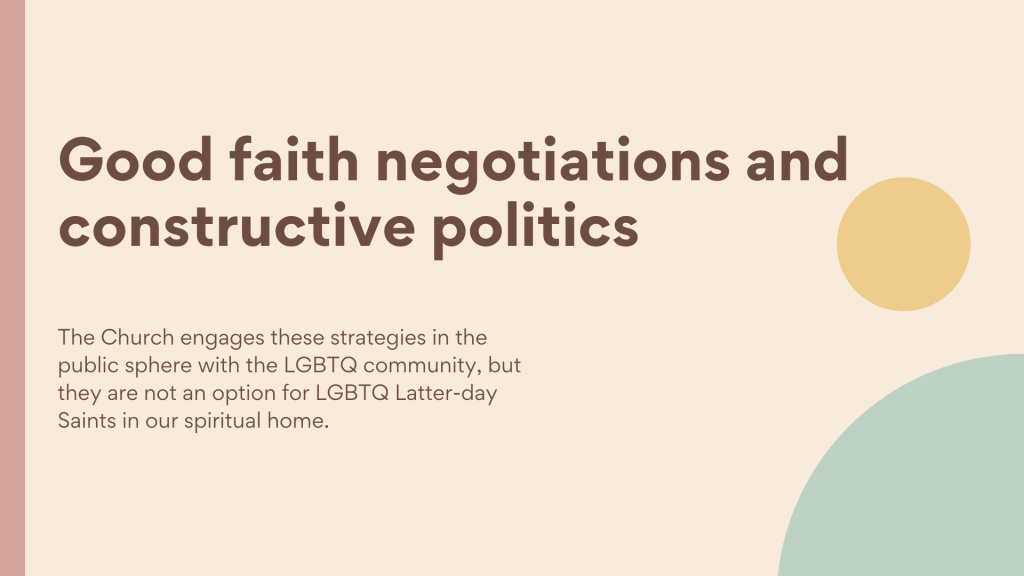
Queer Latter-day Saints and their families within the ecosystem of the Church have a lot, and I mean a lot, to be jealous about concerning the relationship that the Church has put the time, attention, and resources to foster with LGBTQ organizations. I saw this relationship first hand at the Mesa Temple open house where the Church invited leaders of LGBTQ organizations to a night during their VIP week for a personal tour by two apostles.
These recent words of President Oaks present a disconnect that is hard to process in how the Church interacts with Queer people between the public sphere and our faith home, between Civil government and Church government, between equality and just “belonging” under the rainbow stained glass ceiling.
Constructive politics and good faith negotiations are not an option for Queer Latter-day Saints. It’s not a thing. A negotiating table is not a thing.
Queer Latter-day Saints experience a power differential when leaders speak to us as individuals.
What can we do?

President Oaks stated in his speech that the preservation of religious freedom depends on the value the public attaches to the positive effects of the practices and teachings of the Church. It’s a symbiotic relationship between churches and the general public.
Consider as well, that the preservation of the status quo in the Church concerning Queer prejudice, harassment, and discrimination depends on the value the members attach to the positive effects of the practices and teachings of the Church on this matter. It is a symbiotic relationship between the Church and its people.
If you attach no value to Queer prejudice and acts of prejudice within the Church, the time has come to speak up loud and proud, and if you feel like you are already doing this, the time has come to step up your game. We absolutely need our allies, families, and friends to courageously step up here, because your voices can go to the heart of privilege where ours cannot go. In the spirit of President Oaks’ remarks, it is time to publicly — and in the pews — start attaching the negative effects of the practices and teachings of the Church on this matter because we don’t have the tools of good faith negotiations or constructive politics. Unlike our Queer community leaders, we do not have the luxury of a negotiating table to bring about change. This is not a “belief” or “faith” matter. This is a “prejudice” and “acts of prejudice” matter.
Question the status quo.

If a question was good enough to start the Restoration of the Church in 1820, it’s good enough now to begin to make a movement in LGBTQ spiritual equality today. If you are feeling shy about speaking out, just remember that Jesus teaches us that the continual questioning of the importunate widow gets results. She was not shy at all about what the unjust judge thought about her. She kept bugging him and finally got justice.
Each year the Church has to work harder and harder to sustain a system of structural inequality of Queer people in a home-centered, church supported ecosystem. Queer kids are born into Latter-day Saint homes, not into the Church. When you offer Latter-day Saint families less protections and equality in the Church for their Queer kids than what is granted them under the Constitution, it doesn’t matter how politely and eloquently you present religiously accepted prejudice and acts of prejudice—today’s parents want their children to have the same opportunities and happiness that they have experienced in life.
Let’s take a moment and talk about how the Church presents life under the rainbow stained glass ceiling in the most appealing way they can.
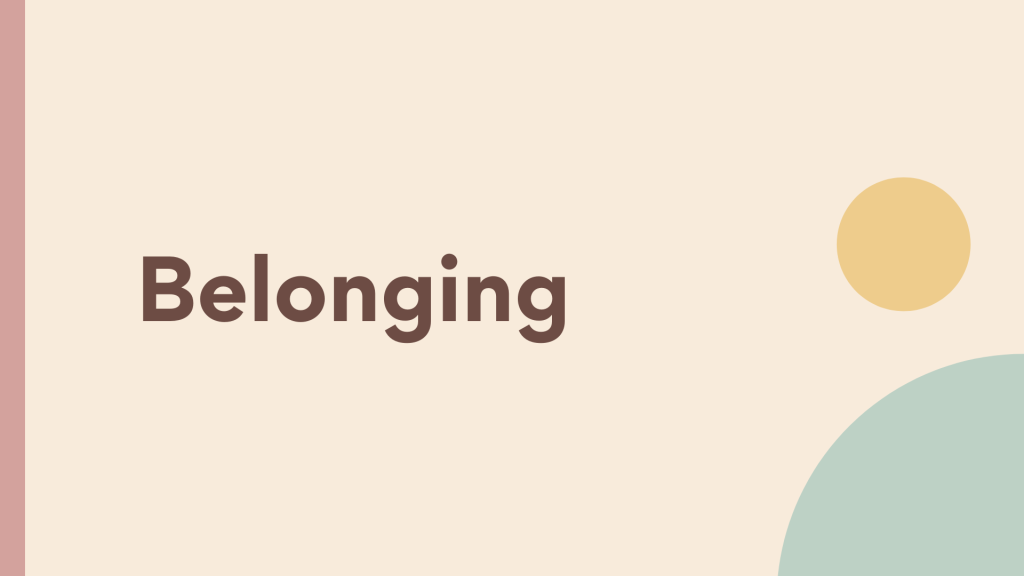
First, you must really drive home the concept of “Belonging.”
The draw of belonging to church, family, and God is a huge factor in the stability of a Queer person’s life. This is all made a conditional safe space of belonging, where as long as they remain single and celibate or non-transitioned, they will be celebrated, accepted, and a part of the community of Saints. Instead of facing the outright rejection and hostility many of the older generations of Queer Latter-day Saints experienced, today it is the practice to never threaten a sexual minority, only threaten their “belonging.”
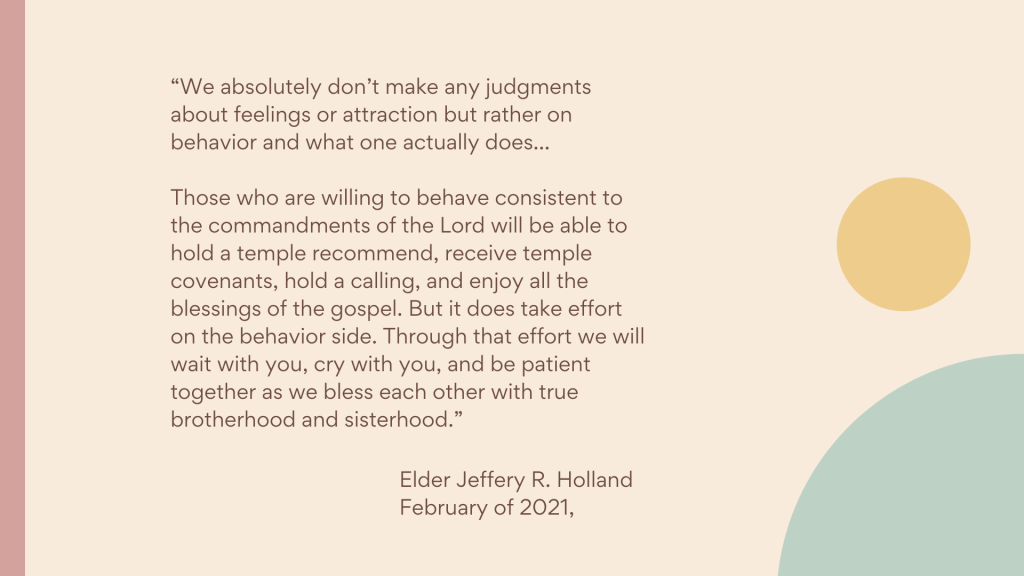
We saw this in full view during a Young Adult devotional in February of 2021, where Elder Jeffery R. Holland addressed the issue of sexual minorities in the church and adamantly told the young adults that,
“We absolutely don’t make any judgments about feelings or attraction but rather on behavior and what one actually does…Those who are willing to behave consistent to the commandments of the Lord will be able to hold a temple recommend, receive temple covenants, hold a calling, and enjoy all the blessings of the gospel. But it does take effort on the behavior side. Through that effort we will wait with you, cry with you, and be patient together as we bless each other with true brotherhood and sisterhood.”
Let’s be clear at what is happening here. The church is not just asking sexual minorities to refrain from sexual relations before marriage like they ask of straight members of the church. That is not what Elder Holland is inferring at all. That would be an equal ask.
Instead, he is threatening the very belonging of sexual minorities in the church if they act like their straight peers, claim equality, and marry according to their orientation. Everyone is the same until you start marrying, then the current management of the homosexual population in the church kicks in and you find that all along your life in the church has been structured by prejudice, harassment, and discrimination.

Second, you need to sell, sell, sell life under the rainbow stained glass ceiling. Market it like a timeshare. To do this you need spokespeople. You need stories of other Queer Latter-day Saints who are doing it, and lots of them.
During the 1960s through the 2000s there was absolutely no market for Queer stories in the Church. Our story currency was worthless and flatly rejected as counterfeit. At best it was used as a cautionary tale about the wages of sin.
Then in 2016 the Queer Latter-day Saint story marketplace blew wide open and the value of Queer stories skyrocketed when the Church introduced their new Mormon and gay web resources and placed it on the official church website. The Church itself created the market for Queer Latter-day Saint stories.
Not every Queer story is useful to the Church. The Church has a particular story they traffic in, one that requires a particular set of skills. Every story must come from someone under the rainbow stained glass ceiling who can tell the story that they are faithfully managing life under the rainbow stained glass ceiling. Using a mix of rugged, good looking, smart, athletic, relatable, heteronormative, Mormonormative, Queer Latter-day Saints, stories are used to build an unsustainable model to show parents and Queer kids, “Look! All the popular kids are doing it!”
The problem is, life under the rainbow stained glass ceiling is a hot mess. Most of the original single and celibate Mormon and gay website gang got married.

Currently over at Desert Book, the Church has lost control of the gays. Tom Christofferson announced that he has started dating (Good for him!), Charlie Bird a.k.a Cosmo the Cougar, announced just this week that even though he is a BYU student, he has been dating, (Congratulations Charlie! Also, I won a bet with the Church Communications Department that this would happen!) and the third, Ben Schilaty, who is an honor code administrator for BYU knew of Charlie’s relationship long before Charlie announced it, but kept it quiet to protect his friend.
We absolutely cannot blame or fault these Queer souls, but we can be disgusted at the power centers that look over our Queer stories, curate them, and then thieve them to build a dominant narrative about Queer people that simply isn’t true.
Stories on Church platforms are a continual revolving door as Queer Latter-day Saints navigate themselves out from under the dominant narrative towards joy and equality. I wish parents and young Queer kids who look up to these stories and hold unreasonable expectations knew this. In full transparency, the Church really should do a “Where are they now” reunion video with everyone from their past story platforms.
The Church isn’t the only consumer of Queer stories. Lots of people and organizations traffic in our stories and even thieve them to support their own agenda. Queer Latter-day Saint stories are a hot commodity right now. They are all over the internet in Latter-day Saint adjacent podcasts, social media, YouTube channels, websites, books, magazines, radio, and TV.

With all this content, what is the best way to evaluate Queer Latter-day Saint stories to come to understand the truth about Queer joy?
Like a historian.
My husband, Matthew, is a historian.
As Matthew moves his world history students at Arizona State from the 16th century to modern history, he comes to a point in time where the history stops, and the course is over because they are to the point where current events begin. Current events are not history. Current events are journalism.
Where is the inflection point where journalism becomes history? It’s not a point really, it’s a zone of transformation that is dependent on a couple of things:
1. First, enough time has passed that sufficient reports and documents have been archived and readily available for inspection to build a complete record.
2. And second, enough time has passed that the power structures under study become irrelevant, meaning that their influence is less or no longer important. Power structures have immense resources to reframe and restructure a current narrative and time provides enough distance where the historian is able to look at material free from their influence.
As historians move backward in the timeline, journalism transforms into history and all the archived stories and experiences become primary sources for historians to gather, read, catalog, and organize in order to build an accurate account of the past.

Any credible historian does not write a history and then go looking for primary sources to support it.
Instead, the primary sources independently reveal the history.
Understanding this, how do we approach the huge pool of contemporary Queer stories with the tools of a historian if we are still living in a journalistic present?
First, remember that power structures wield immense resources to reframe and restructure a current narrative. A power structure, like the Church, has already written a narrative about Queer people and they now are out looking for Queer stories to sustain the narrative.
To counteract this power, don’t approach a Queer story as if it is true or false. Do not analyze it as either sustaining power structure’s dominant narrative or contradicting it.
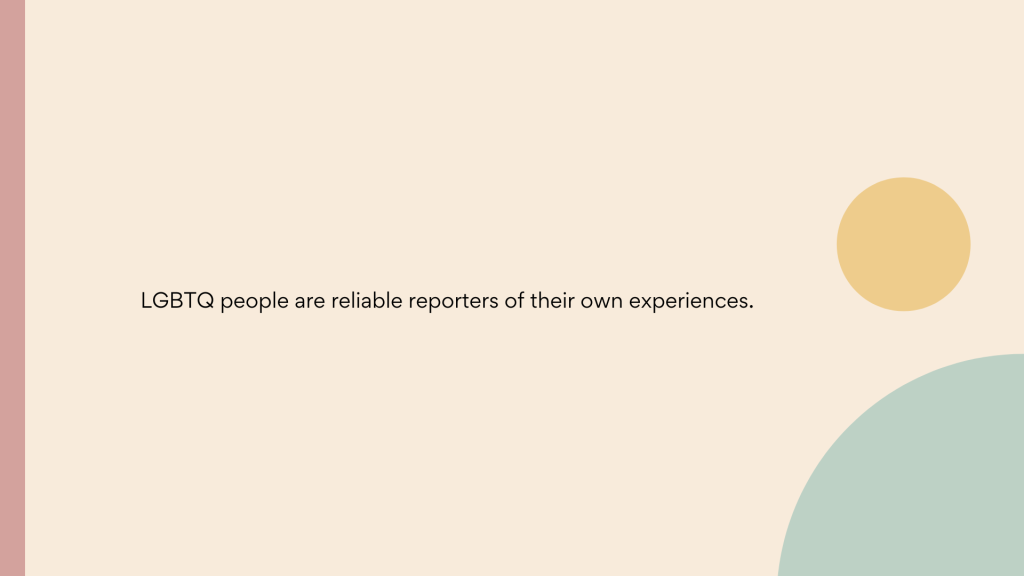
Instead, consider Queer people reliable reporters of their own experience.
Allow yourself to sit with and accept each story as a valid experience. Listen to as many Queer stories in as many different and diverse places as you can. Like a historian, gather, listen, catalog, and organize each experience and begin to build an accurate account of Queer people’s experiences as they navigate their intersection with the Church. Let the stories show you an accurate account instead of being influenced by the pressures of a power structure advancing its dominant narrative.
This is our intersection as a Queer people and we are giving you the gift of our stories to understand it as it really is and how it really feels — and that is the power of the Queer story that absolutely threatens the dominant narrative built by a power center. Our collective lived experiences build the accurate picture of unashamed authenticity and absolute Queer joy, even in the face of prejudice, harassment, and discrimination.

Hundreds if not thousands of compelling stories exist of Queer people who are or were Latter-day Saints. Most often those that are no longer in the Church didn’t leave because they no longer believed. They were forcibly removed because they refused to be managed by acts of prejudice. This is why you cannot just focus on approved Church Queer voices. You will miss the complete and true picture.
Next time you are at Deseret Book or reading a Church magazine ask yourself, “Where are all the diverse profiles of courage and achievement and why are they not here?”

Where is the story of the Church’s transgender chief temple architect—Laurie Lee Hall’s story? You know her work. To name just a few of her 40+ projects: The Gilbert Arizona temple, Phoenix Arizona temple, the Oquirrh Mountain Temple, the Provo City center temple.

She was the one to put it up on stilts to save the old Provo Tabernacle from complete ruin. You all saw those remarkable pictures.

Thousands of young missionaries sit in the Provo MTC where she designed spaces to specifically be conducive to the Spirit. Just think of that. All missionaries sent out into the world from the Church’s main training center have felt the Spirit in spaces that a transgender woman thoughtfully created for them.
Despite her breathtaking buildings, physical icons of a church connecting heaven to earth, she was forced from her position and excommunicated from the Church for no other reason than she was a transgender woman.
Our transgender Latter-day Saints need to know her story. All of us need to know her story. We talk in venerated tones about Truman O. Angell, the architect of the Salt Lake Temple.

Yet at the moment the only reference we currently hear of Laurie is in a weirdly specific example in an amicus brief the Church filed with the Supreme Court to oppose LGBTQ equality in the workplace.
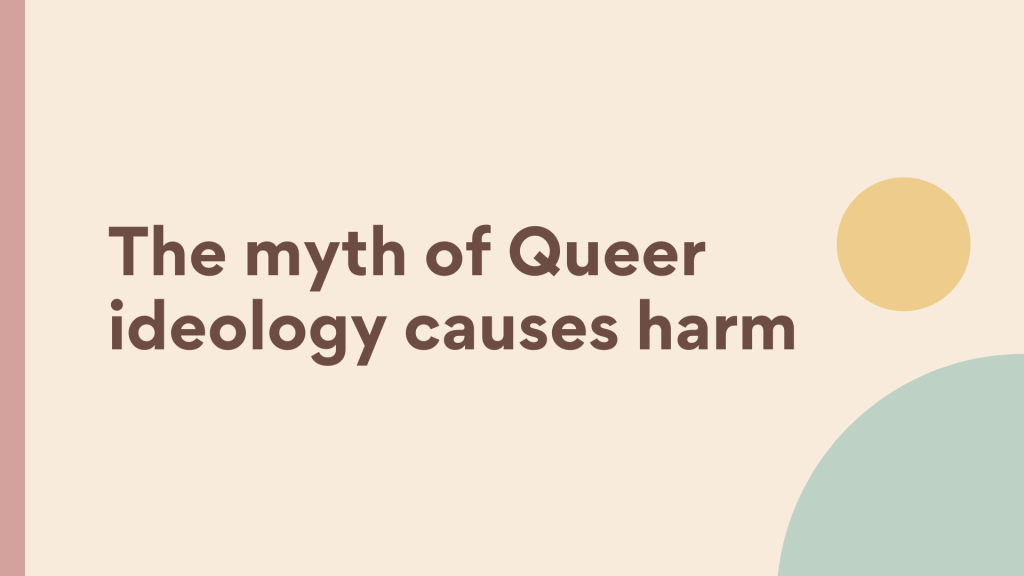
In today’s climate, to sustain a narrative of inequality and discrimination tenable to a modern membership, you cannot directly attack LGBTQ people like it’s the 1970s.
Instead, LGBTQ people today are reduced to a behavior—a belief or an ideology. Once this happens you couldn’t care less how people identify, now you can attack the behavior. Now you can attack the ideology such as when President Oaks lamented the “increasing frequency and power of the culture and phenomenon of lesbian, gay and transgender lifestyles and values.”
Every time you see a Liahona article about Queer people, hear General Authorities discuss Queer issues, read Church social media posts about Queer people, you are witnessing the struggle to transform Queer people into an ideology beholden to prejudice and acts of prejudice protected by religious freedom.
You cannot expect progress in the Restoration when the handbook calls on members to abandon their own prejudice and actions of prejudice but the institution retains the right to practice—in full view of the membership—religious prejudice that structures the everyday life of the Queer Latter-day Saint by discrimination and harassment.
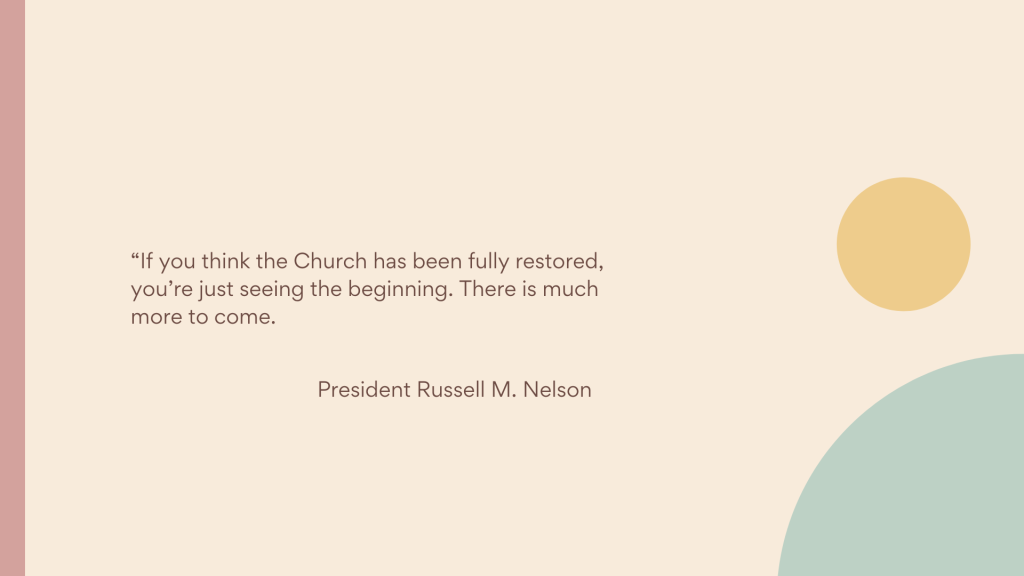
President Russel M. Nelson tells us that the Restoration is ongoing. We sing that the Restoration breaks like the morning, dawning at the speed of light, majestically rising on the world. In the matter of Queer people in the Church, when you weigh the Restoration down with prejudice and discrimination, you slow the Restoration down to baby steps.
When you slow the Restoration, the aging of Queer people does not slow down. A slow Restoration means that Queer Latter-day Saints grow old while suspended indefinitely in an abjectly unfair ideological state of stasis founded in prejudice. How long do you ethically hold your Queer children there? How long can you ethically tell them to be patient and wait? You can sit with them, cry with them, celebrate them, but in the end, as a straight cisgender person you are free to move about the Restoration while Queer members are restricted to the margins.

Reduced to an ideology in a system structured by prejudice, harassment, and discrimination, Queer people in the Church become the Lazarus of our day — damned in progression, still as death, entombed, unable to move any further in the mortality of our spiritual home, waiting on others to either roll away the stone of revelation and call us forth or pass to the other side where God will have to pick up the work of equality and justice that his children could not do in his name here on Earth.
We will not languish in the tomb forever. Queer people were not born for baby steps, we were born to run, to rise. We were born with inherent self-worth and inalienable human rights.
Yet after we are born, we are carefully captured in our progress in the Church and held in stasis, as if in the tomb of Lazarus, immobilized by the shrouds of prejudice, discrimination, and harassment in a Restoration of Queer baby steps while our straight cisgender peers fly past, enveloped in privilege, and rising in opportunity and full accommodation of their sexual orientation and gender.
Unable to kickstart the Restoration, Queer people are not helpless hostages. We hold one of the most powerful gifts of the Restoration: personal revelation. Personal revelation is the check and balance to the fallibility of the humans who are called to drive and administer the Restoration in our day.
Our personal revelation empowers us to claim our authenticity in the face of prejudice and acts of prejudice, not wait for baby steps and not wait to be acted upon. Let the Restoration catch up with us. The current “ask” is that we patiently hold in the tomb, under the rainbow stained glass ceiling, while we faithfully accumulate the stench of Lazarus.
When the day comes that the stone is finally rolled away, you will not be met with the stench of Lazarus.
You will not be met by Lazarus.

Instead, you will find this tomb empty. For this was not a tomb of Lazarus after all, but a tomb of Joseph of Arimathea from which we have already risen to walk the path of joy and progression that God has laid out before us.
You will need to come find us.
This is not a matter of having a weak faith. It is silly to say that being authentically Queer equals having a faith crisis. We are not faithless or unspiritual. Like all people, we navigate towards joy not the darkness of a tomb.
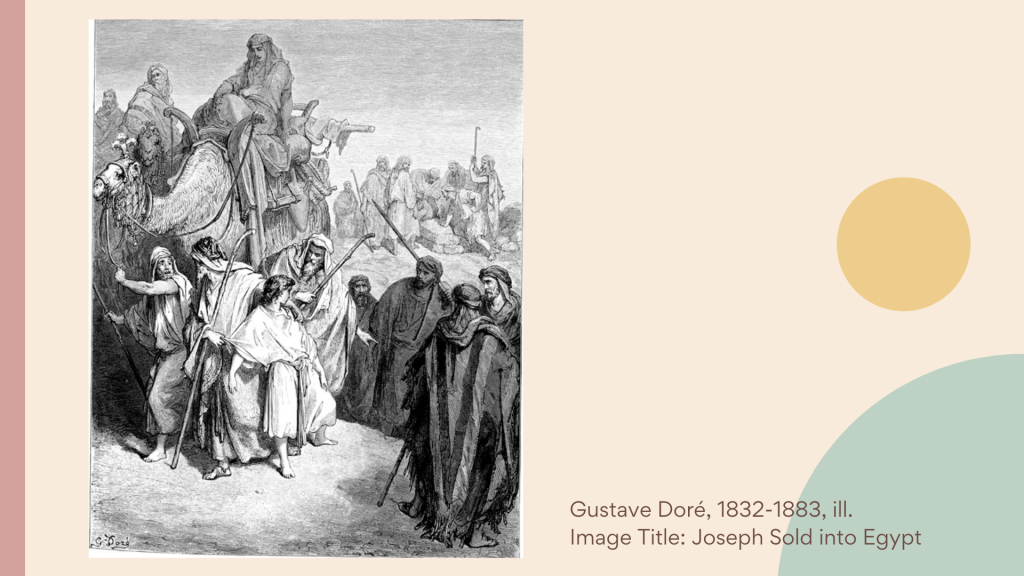
As long as the rainbow stained glass ceiling remains unshattered, you will continually be wishing your Queer children goodbye. It doesn’t matter how sincere your well wishes are, how tearful the goodbyes. Collectively as a Church, you are as the children of Israel who have stripped us of our identifiable coat of many colors and separated us from our spiritual home, selling us for silver, and then misrepresenting to our Father why we have gone missing. It does not have to be like that. We do not have to wait until Egypt to embrace.
Where is the hope currently for all who are navigating this intersection? First of all, it is not about the intersection. It is always about the navigator. The hope is that so many Queer Latter-day Saints courageously navigate towards joy to stand in places that feel safe and healthy for them in the face of some pretty intimidating prejudice and acts of prejudice.
Celebrate the navigator not their captors and not the seas full of underwater hazards. Celebrate the hope that the continual wave of beautifully perfect Queer Children born to Latter-day Saint families will find refuge and protection in their homes, shielded from a spiritual culture of muskets and fire.
To all my Queer peers who are navigating to their joy, towards Love, guided by the Spirit in personal revelation through these waters of prejudice, I affirm you. I celebrate you. No toil or labor fear as you wend your way. I cheer for you that you will find the place which God has prepared for you.
Don’t stop!
Keep going.
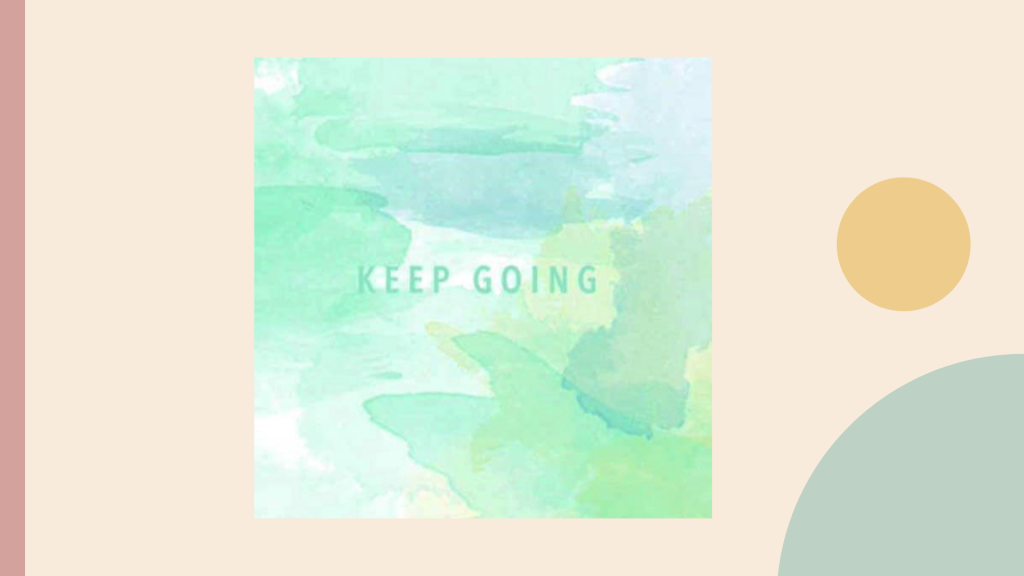
the problem at present is the handbook says the church’s teaching on marriage will not change, which unfortunately does reduce the issue down to a binary choice.
i’m encouraged by president nelson’s recent tweet on martin luther king jr day. “may God continue to bless us as we labor together to abandon attitudes and actions of prejudice”.
i’m struggling to know the course to chart as an ally. on one hand, i know it’s true, and have a satisfactory personal witness of that. and if either of my kids came out to me, i would immediately stop going and consider resigning. however, should i do that anyway? i’m fairly sure my kids are/will be cisgender and heterosexual but regardless, should i really expose them to these awful attitudes when they are likely to absorb them? we talk to them about gay relationships, and specifically correct any notion that there is anything wrong with people who are (like when they tried to use “gay” as an insult), would that be enough?
i’m not much of an advocate, but do i spend whatever remains of my membership advocating, and just accept that at some point i’m likely to be excommunicated (out of love, obviously)? it’s a hill i’m prepared to die on, but do i actively seek it out?
is questioning the current direction rehearsing my doubts?
many questions. not enough brain power :'(
Thank you Nathan for the excellent presentation. I hope you were able to speak in front of a full house of youthful Latter-day Saints of various orientations. At age 77, I have been writing my story as a Latter-day Saint. Unlike many, because of my age, I have lived through the history of changes that you related in your well written speech. After 8 years of writing I delivered the original manuscript to my children, and grandchildren this past Christmas. I have spent over a year trying to edit it for publication… not knowing it I shall ever find someone to publish it… yet I am somehow driven to do so. I know one day, perhaps when I am gone… the Church will open its doors for all of us to be equal. Unfortunately, for those whose lives were filled with self-hatred because of ever-changing “policies” that defined who we were and how we were to be accepted… or not be accepted… will have passed on having been denied the opportunity of truly enjoying the fullness and beauty of our own existence. Perhaps, this in itself, is why I keep writing, if not for others, but at least, for myself.
Dean, thank you for sharing this. I had a friend tell me once, that when we write, we write ourselves into existence. Your valuable writing builds our collective narrative and, I believe, in the writing of our experiences it is also very personally healing. Sending love.